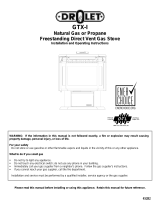
6
Waterford E65-1 Emerald Direct Vent Freestanding Gas Stove
IMPORTANT:
SAVE THESE
INSTRUCTIONS
The EMERALD Direct Vent Freestanding Gas
Stove must be installed in accordance with
these instructions. Carefully read all the in-
structions in this manual first. Consult the build-
ing authority having jurisdiction to determine the
need for a permit prior to starting the installation.
Note: Failure to follow the instructions
could cause a malfunction of the
heater which could result in death,
serious bodily injury, and/or prop-
erty damage. Failure to follow
these instructions may also void
your fire insurance and/or war-
ranty.
Note: These instructions take prece-
dence over Simpson Dura-Vent
instructions.
SPECIFICATIONS
Fuels: E65-NG1 is approved for use with
natural gas.
E65-LP1 is approved for use with
liquefied petroleum gases (propane).
Electrical: 120V A.C. system.
Circulation Fan: Variable speed, 125/75.
Log Sets: Ceramic fibre, 3 per set.
Vent System: Coaxial (6-5/8" outer / 4" inner
liner) rigid flue and termination cap.
The efficiency rating of the appliance is a
product thermal efficiency rating determined
under continuous operating conditions and
was determined independent of any installed
system.
INFORMATION FOR
MOBILE/
MANUFACTURED
HOMES AFTER
FIRST SALE
This Waterford product has been tested and
listed by Warnock Hersey as a Direct Vent
Room Heater to the following standards: CAN/
CGA 2.17-M91 and ANSI Z21.88b-2003/CSA
2.33b-2003.
INSTALLATION
This Direct Vent System Appliance must be
installed in accordance with the manufacturer's
installation instructions and the Manufactured
Home Construction and Safety Standard, Title
24 CFR, Part 3280, or the current Standard of
Fire Safety Criteria for Manufactured Home
Installations, Sites, and Communities ANSI/
NFPA 501A, and with CAN/CSA Z240-MH Mo-
bile Home Standard in Canada.
This appliance installation must comply with the
manufacturer's installation instructions and lo-
cal codes, if any. In the absence of local codes
follow the current National Fuel Gas Code, ANSI
Z223.1 and the current National Electrical Code
ANSI/NFPA 70 in the U.S.A., and the current
CAN/CGA B149 Gas Installation Code and the
current Canadian Electrical Code CSA C22.1 in
Canada.
BEFORE YOU START
Safe installation and operation of this appliance
requires common sense, however, we are
required by the Canadian Safety Standards
and ANSI Standards to make you aware of the
following:
1) Provide adequate clearances for servic-
ing, proper operation and around the air
openings into the combustion chamber.
2) The appliance must be installed on a flat,
solid, continuous surface (e.g. wood, met-
al, concrete). This may be the floor, or it can
be raised up on a platform to enhance its
visual impact. The appliance may be in-
stalled on carpeting, tile, wood flooring or
other combustible material, because the
appliance's metal pedestal base extends
the full width and depth of the appliance.
The EMERALD Direct Vent Freestanding
Gas Stove can be installed in a wide variety
of ways and will fit nearly any room layout.
It may be installed in a recessed position,
framed out into the room, or across a
corner.
3) The EMERALD Direct Vent Freestanding
Gas Stove is approved for alcove installa-
tions, which meet the clearances listed on
page 7. This unit is approved for manufac-
tured home installations, see page 8 and
THE CONTROL COMPARTMENT,
BURNERS AND CIRCULATING AIR
PASSAGEWAYS OF THE APPLI-
ANCE BE KEPT CLEAN.
DUE TO HIGH TEMPERATURES,
THE APPLIANCE SHOULD BE LO-
CATED OUT OF TRAFFIC AND
AWAY FROM FURNITURE AND
DRAPERIES.
WARNING: FAILURE TO INSTALL
THIS APPLIANCE CORRECTLY
WILL VOID YOUR WARRANTY AND
MAY CAUSE A SERIOUS HOUSE
FIRE.
CHILDREN AND ADULTS SHOULD
BE ALERTED TO THE HAZARDS
OF HIGH SURFACE TEMPERA-
TURES, ESPECIALLY THE FIRE-
PLACE GLASS, AND SHOULD
STAY AWAY TO AVOID BURNS
OR CLOTHING IGNITION.
YOUNG CHILDREN SHOULD BE
CAREFULLY SUPERVISED WHEN
THEY ARE IN THE SAME ROOM AS
THE APPLIANCE.
CLOTHING OR OTHER FLAMMA-
BLE MATERIAL SHOULD NOT BE
PLACED ON OR NEAR THE APPLI-
ANCE.
This Waterford Mobile/Manufactured
Home Listed appliance comes factory
equipped with a means to secure the
unit.
This Waterford Mobile/Manufactured
Home listed appliance comes
equipped with a dedicated #8 ground
lug to which an 18 gauge copper wire
from the steel chassis ground must be
attached.
This appliance may only be installed in
an aftermarket permanently located,
manufactured (mobile) home, where
not prohibited by local codes.
This appliance is only use with the
type of gas indicated on the rating
plate. This appliance is not converti-
ble for use with other gases, unless a
certified kit is used.
INSTALLATION AND REPAIRS
SHOULD BE DONE BY A QUALI-
FIED SERVICE PERSON. THIS AP-
PLIANCE SHOULD BE INSTALLED,
REPAIRED, INSPECTED BEFORE
USE AND AT LEAST ANNUALLY
BY A QUALIFIED SERVICE PER-
SON. MORE FREQUENT CLEAN-
ING MAY BE REQUIRED DUE TO
EXCESSIVE LINT FROM CARPET-
ING, ETC. IT IS IMPERATIVE THAT





















